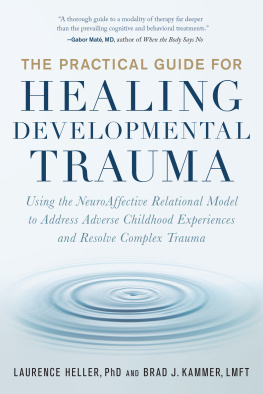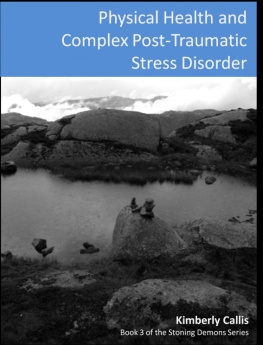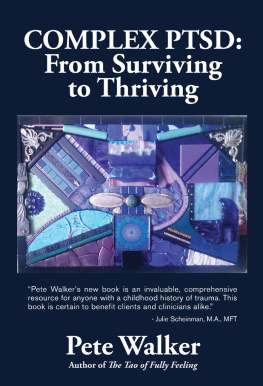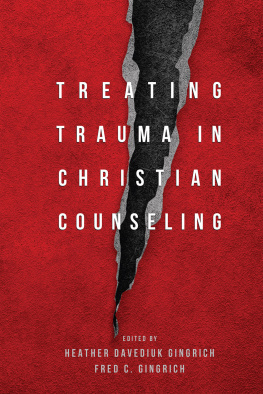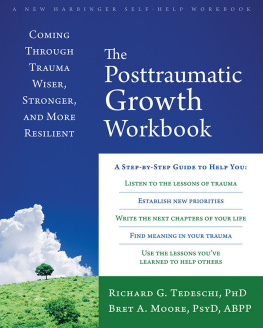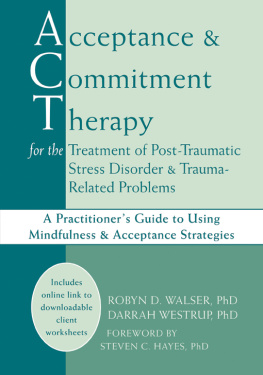
Copyright 2022 by Laurence Heller and Brad Kammer. All rights reserved. No portion of this book, except for brief review, may be reproduced, stored in a retrieval system, or transmitted in any form or by any meanselectronic, mechanical, photocopying, recording, or otherwisewithout the written permission of the publisher. For information contact North Atlantic Books.
Published by
North Atlantic Books
Huichin, unceded Ohlone land
aka Berkeley, California

Book illustrations provided courtesy of NARM Training Institute, LLC
Cover image pavlinec via Getty Images
Cover design by Rob Johnson
Book design by Happenstance Type-O-Rama
The Practical Guide for Healing Developmental Trauma: Using the NeuroAffective Relational Model to Address Adverse Childhood Experiences and Resolve Complex Trauma is sponsored and published by North Atlantic Books, an educational nonprofit based in the unceded Ohlone land Huichin (aka Berkeley, CA) that collaborates with partners to develop cross-cultural perspectives; nurture holistic views of art, science, the humanities, and healing; and seed personal and global transformation by publishing work on the relationship of body, spirit, and nature.
MEDICAL DISCLAIMER: The following information is intended for general information purposes only. Individuals should always see their health care provider before administering any suggestions made in this book. Any application of the material set forth in the following pages is at the readers discretion and is their sole responsibility.
North Atlantic Books publications are distributed to the US trade and internationally by Penguin Random House Publisher Services. For further information, visit our website at www.northatlanticbooks.com.
Library of Congress Cataloging-in-Publication Data
Names: Heller, Laurence, 1944 author. | Kammer, Brad J., 1972 author.
Title: The practical guide for healing developmental trauma : using the
neuroaffective relational model to address adverse childhood experiences
and resolve complex trauma / Laurence Heller, PhD, and Brad J. Kammer,
LMFT, LPCC.
Description: Berkeley, California : North Atlantic Books, [2022] | Includes
bibliographical references and index.
Identifiers: LCCN 2021060506 (print) | LCCN 2021060507 (ebook) | ISBN
9781623174538 (trade paperback) | ISBN 9781623174545 (ebook)
Subjects: LCSH: Psychic trauma in childrenTreatment. | Psychological
child abuse. | Psychotherapy.
Classification: LCC RJ506.P66 H425 2022 (print) | LCC RJ506.P66 (ebook) |
DDC 618.92/8521dc23/eng/20220124
LC record available at https://lccn.loc.gov/2021060506
LC ebook record available at https://lccn.loc.gov/2021060507
Acknowledgments
We both want to acknowledge and thank our editor Shayna Keyles and the North Atlantic Books staff. We are proud to contribute to the mission of North Atlantic Books and have appreciated their guidance and encouragement.
We want to thank our colleagues Stefanie Klein, Marcia Black, Ann Shine Duck, Kelli Klinger, and Sherri Sharkins. They provide steady, heartfelt leadership within the NARM Training Institute and have given invaluable support and guidance in our writing this book. They are outstanding psychotherapists and, even more, wonderful human beings.
We want to express our gratitude for the outstanding team at the NARM Training Institute, who have all helped us fulfill our vision to create a heartful and skillful professional community that can bring this important work into the world. A special thank you to Tori Essex for all the technical help.
Larry
My relationship with Brad goes back more than twenty years. First as his teacher, then when he began assisting me, and more recently as he has become a NARM teacher and the director of training at the NARM Training Institute. When I reconnected with Brad during the first NARM training in Los Angeles, he kept asking me what I experienced at the time as irritating questions. It turned out that over time those questions spurred me on to be more concrete about exactly what I was doing in sessions and what I was teaching. For that Ill always be grateful. It turned out that he became one of the quickest people to grasp the deeper structure of the NARM approach.
The creation of this book together about the NARM therapeutic model represents the culmination of those two decades. Brad has an incredible capacity for not only remembering material that was presented over a long period of time but synthesizing it and structuring it in a way that the reader finds accessible and informative. He is one of the hardest working people I know. His brilliance, heartfulness, and his dedication to this project together have made our collaboration joyful and creative. To you, Brad, my deep and ongoing thanks.
I also want to add my thanks to the NARM trainers in the US and Europe for their long-term support, interest, and encouragement. As well as to all the NARM training assistants in the US and Europe for their dedication and heartfelt support.
I want to thank my life partner, Rachel, for her consistent, loving encouragement.
To my son, Kevin, his partner, Bianca, and my granddaughter, GretchenIm so glad that youre in my life.
Brad
I want to express my deep gratitude for Larry. I feel so fortunate to have had such a gifted and caring mentor, and now partner, to support me throughout my career. I first started out as his student. Some years later, we began teaching together. We quickly realized that we balanced each other and were well-matched creative partners. This partnership led to the creation of the NARM Training Institute, as well as to this book, where we are actualizing our vision to share NARM in a more accessible way with the world. I appreciate Larry trusting me to be a collaborative partner in the evolution of NARM.
When I first met Larry over twenty years ago in a college classroom in Vermont, he introduced me to a whole new way of understanding humanity. He shared with me the tools to heal my own complex trauma, and in so doing, a pathway to reconnecting to my heart. I am deeply grateful for his mentorship, collaboration, compassion, and support.
I would not be where I am if not for the connection and support from Stefanie Klein. Together we have navigated the unchartered territory of running a training institute and have spent countless hours learning, failing, trying again, growing, and expanding the limits of who we are and what we have to offer. I deeply respect Stefanies thoughtfulness, caring, humor, and integrity, and I am so very thankful for our teamwork and meaningful friendship.
My relationship with Marcia Black has supported me personally and professionally for nearly twenty years. Together, we have traveled this NARM journey from the beginning, and we have shared rich learning experiences filled with moments of laughter, tears, healing, and growth. In her professional and personal life, she models the humanity of NARM by leading with a spirit of generosity and care. I specifically want to thank Marcia for giving me such a beautiful, quiet space to get away and focus on writing this book.
I have had the great pleasure to work with so many passionate helping professionals within the NARM international community. These incredible folks, passionate about healing complex trauma and supporting post-traumatic growth, have taught me so much and have inspired the writing of this book. I want to especially thank our NARM training assistants, who bring so much compassion and heart to our training community.
Next page
